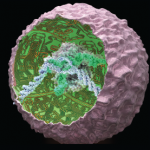Dr. Guilak’s laboratory first approached this question by using drug-eluting fibers to engineer a system for long-term delivery of anti-rheumatic drugs. As they designed their system, they met the challenges of high concentrations, long-term delivery and dynamic response. As they sought to deliver a therapeutic molecule in a manner that would meet these challenges, they realized the answer required them to pivot to deliver a gene instead of a protein.
Their new solution packaged the gene coding for an inhibitor of the interleukin (IL) 1 receptor (IL-1 receptor antagonist or IL-1Ra) behind a doxycycline (dox) inducible promoter and placed it inside an inactivated lentivirus, which they used to coat the scaffold. The lentivirus remained attached to the scaffold and did not circulate through the body. Thus, the team was able to deliver an anti-rheumatic drug (anakinra) locally via engineered cartilage. According to Dr. Guilak, this approach provides a foundation for using total biological cartilage resurfacing to treat end-stage OA—an approach that may be particularly useful for young patients who currently have few therapeutic options.1
Disease Flares
Dr. Guilak then posed the question: Is it possible to program intelligence into cells so they can autoregulate the gene expression? Although the dox-inducible promoter made it possible to turn the IL-1Ra gene on or off like a faucet, it was difficult to know when to turn the gene on and off to stop inflammation when a flare occurs in the joint. So the laboratory strove to create designer smart cells capable of delivering biologics in an auto-regulated manner when they sense inflammation. To accomplish this, researchers identified a cell that normally had an inflammatory response and hijacked its pathway.
Dr. Guilak explained the process by asking the audience to imagine a cell as a simple iPhone, which contains short snippets of code. The researchers cut out that code and inserted it into stem cells using the CRISPR/Cas9 system. Thus, they created a synthetic gene circuit, so when the resulting smart cell sees tumor necrosis factor (TNF), it responds by synthesizing a TNF inhibitor. These smart cells can respond rapidly in vivo, allowing for time- and dose-dependent dynamics. In this way, Dr. Guilak’s laboratory customized the intrinsic cellular signaling pathways in stem cells, thereby, opening the possibility of safer and more effective therapeutic approaches for a wide variety of diseases.2
Such smart cells, when integrated onto scaffolds, can form smart implants that combine the genome and epigenome to create an artificial circuit that responds to a pre-identified stimulus. The result is a combination of gene editing, synthetic biology and tissue engineering to create designer cells that have prescribed cell‐surface molecules and receptors, as well as synthetic gene circuits.
